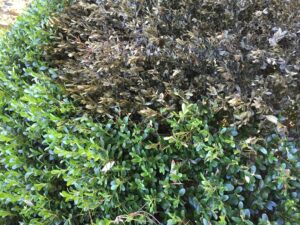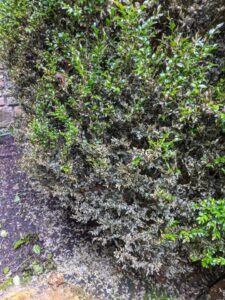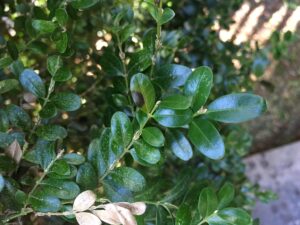Pest Alert – Boxwood Blight
go.ncsu.edu/readext?833736
en Español / em Português
El inglés es el idioma de control de esta página. En la medida en que haya algún conflicto entre la traducción al inglés y la traducción, el inglés prevalece.
Al hacer clic en el enlace de traducción se activa un servicio de traducción gratuito para convertir la página al español. Al igual que con cualquier traducción por Internet, la conversión no es sensible al contexto y puede que no traduzca el texto en su significado original. NC State Extension no garantiza la exactitud del texto traducido. Por favor, tenga en cuenta que algunas aplicaciones y/o servicios pueden no funcionar como se espera cuando se traducen.
Português
Inglês é o idioma de controle desta página. Na medida que haja algum conflito entre o texto original em Inglês e a tradução, o Inglês prevalece.
Ao clicar no link de tradução, um serviço gratuito de tradução será ativado para converter a página para o Português. Como em qualquer tradução pela internet, a conversão não é sensivel ao contexto e pode não ocorrer a tradução para o significado orginal. O serviço de Extensão da Carolina do Norte (NC State Extension) não garante a exatidão do texto traduzido. Por favor, observe que algumas funções ou serviços podem não funcionar como esperado após a tradução.
English
English is the controlling language of this page. To the extent there is any conflict between the English text and the translation, English controls.
Clicking on the translation link activates a free translation service to convert the page to Spanish. As with any Internet translation, the conversion is not context-sensitive and may not translate the text to its original meaning. NC State Extension does not guarantee the accuracy of the translated text. Please note that some applications and/or services may not function as expected when translated.
Collapse ▲Boxwood blight is a fungal infection that kills boxwoods. The fungus is highly contagious, sticking to both people and animals. The disease is incurable.
Here is an image of boxwood blight. In the image you can see black spots on the leaves. This is characteristic for BB. Nothing else makes black spots on boxwood leaves. You will note the heavy defoliation.
The BB disease spreads when it is warm and wet in the spring and summer. This fungus is exceptionally contagious. It has sticky spores that can be spread by people and animals. Home gardeners and landscape workers should be sterilizing tools between properties. Whenever you work around boxwood plants you could bring BB in from another site and then go on to spread it to other properties. BB should be treated like the plague.
Chemical Treatments
Properly applied fungicides can protect boxwood plants from boxwood blight infection. However, chemicals do not cure plants with the disease. The goal of successful chemical applications is to prevent disease because mostly fungicides are preventative.
Apply fungicides when temperatures reach 60°F and rainfall is not expected. Apply fungicides every 7 to 14 days to protect susceptible boxwood, so basically every 2 weeks all summer and fall. That is at least ten sprays per growing season. The fungicides must be applied thoroughly as well. If the weather is exceptionally wet, then fungicides must be applied more often.
Effective products include a rotation of Armada, Subdue, Cleary’s, and Propaconazole. Another rotation includes chlorothalonil or fludioxonil. You will need to apply fungicides every 7 to 14 days to protect susceptible boxwood.
 Avoid introducing the boxwood blight fungus:
Avoid introducing the boxwood blight fungus:
- Purchase boxwood plants from nurseries that participate in a boxwood blight compliance agreement.
- Quarantine plants by separating them from existing nursery stock. Do not spray new plants with fungicides for one month before installation to watch for any BB symptom development. Be sure to also include pachysandra and sweetbox in your scouting program.
- Do not prune boxwoods when they are wet to reduce the chance of spreading disease. Clean and disinfect pruning tools (used on an infected planting) with SA-20, Sanidate, Lysol, bleach, ethanol, or quaternary ammonia before moving to a new area.
- Collect and remove pruning clippings; do not compost infested debris.
- Avoid introducing new boxwood plants to landscapes that already have large, historically important boxwoods. Also, limit human contact with big, historic boxwoods.
- Once the disease is detected, sanitation is critical for management. Remove and bag any diseased plants and fallen leaves and dispose of them in municipal waste or bury them. Where permitted, burn infected plants.
Natives – inkberry holly, dwarf yaupon holly, dwarf conifers
Non-natives – Japanese holly, carissa holly, yew, distylium, dwarf conifers







